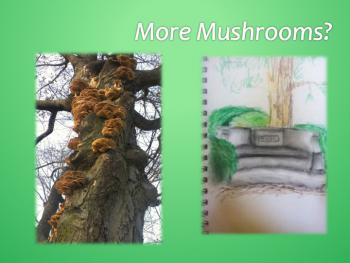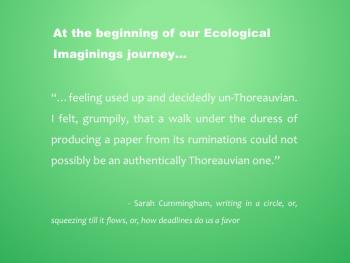Serendip is an independent site partnering with faculty at multiple colleges and universities around the world. Happy exploring!
[PPT] & [Script} Ecological Journey from Campus to the World
The link to the sky burial video from youtube:
http://www.youtube.com/watch?v=b6hSK8CluxQ

Comment if you want to learn more about sky burials!!!!!!!















Introduction:h e sky burial is a funerary practice in Tibet, where human corpse is incised in a certain sacred way and exposed to animal’s consumption. This ceremony is first recorded in the twelfth century and is still practiced nowadays. By looking into the cultural implications and natural causations of this customs, we hope to bring about the ecological thinking we have been utilizing during the semester. We also want to emphasize that, in an academic discussion of ecology, getting to know different cultures is crucial. In much of the texts we have discussed, the horizon is limited by who the author are; yet not few of them indicated applying their theory to all other people. Some of you may know more about sky burial than others do. In this presentation, we are aware that people may not feel well about this ceremony and we do not show pictures of the practice in this slide.
Concept of Sky Burial Slide 2
In the Sacred Life of Tibet, Keith Dowman wrote that “the major sky-burial sites of Tibet are important power places……the common belief that liberation from the round of rebirth, or certainly a better rebirth, can be obtained by disposing of the corpse at one of the great sky-burial sites induces relatives to transport it from far away”. The Sky-burial process was considered as an act of generosity—by providing one’s mortal remains to other sentient beings (233-234), vitality was passed on, as repayment to nature.
2. The Role of Sky Burial in Religious Ecology—Religious Background
The relationship between human and surrounding nature has always been complicated. There was a legend saying that Sakyamuni, the founder of Buddhism, fed himself to a tiger because the tiger was too starved, and later after rebirth the tiger became a believer in Buddhism.
As told in the Dummedha Jataka, the Buddha[YW1] , as a prince of Banaras, was appalled by the animal sacrifice tradition and wished to stop it. When his father died, he did not kill animals but performed his own rituals to the spirit of a banyan tree. After he became the king, he announced that he would offer the tree lives of one thousand human beings who precede the practice of animal sacrifice. (Chapple, 138-140) Thus we could learn that in Indian, Buddhism advocated the equality of all living creatures and asked people to do no harm to innocent animals. To look at this story from a different way, however, we could see a “trade” of lives, potentially meaning that one must sacrifice his or her life for killing other innocent beings.
Slide 4 How nature has shaped this custom:
A large amount of ideas of Buddhism was imported from India to Tibet, so they are in many ways alike. However, in the Tibetan Buddism, there were fewer restrictions to people’s living habits—including the acceptance of marriage and eating meat.
This significant deviation in religion was resulted from the severe environmental conditions—because temperature difference was big and oxygen was lacking, there were hardly any edible plants. Thus, to survive, being vegetarian was an impossible choice. (Becker, 84-85)Sky Burial, for this reason, could be seen as paying back the nature: while human eat animal for a living, animals are provided with human flesh as well. This seemingly brutal and fierce way of embracing nature had, surprisingly, reflected the idea of all creatures being equal and living in a mutually beneficial way.
Barometer:
Wendy Doniger: one can feel empathetically for animals--and kill and eat them
Conclusion – Barbara
We choose to present this unique practice in Tibet because of the complexity of its origin. In the semester, we emphasized to approach to the world holistically and balance the role of ourselves in the ecosystem. The sky burial is a profound theme for us to investigate how nature and human have interacted over time. This practice has been going on for centuries and fascinates a lot of people from other cultures. For Tibetans, it is not only a practical funerary method but have more religious implications and cultural meanings. Religion, geology, and biology all have their influence on shaping this practice. It also is provocative for people to thinking about the meaning of life. Are body and spirit separable? What we become of after death? Reflected by the sky burial, these people have a willingness both to give back and to go back to the nature when life ends.
Lastly, due to the time limit, we did not have a chance to show the class how the ceremonial is like. On one hand, we have a lot to discuss here. On the other hand, we were sure about to what extent you would accept this whole concept. If you are interested, there is a well-made video clip which recorded a modern practice of this ceremony. It is worth watching. Actually seeing the natural environment of the area and hearing what Tibetan themselves say about this tradition will, I believe, help you rethink what we have presented here today.
References
the Sacred Life of Tibet, Keith Dowman
Animals and Environment in the Buddhist Birth Stories, Christopher Key Chapple
Breaking the Circle: Death and the Afterlife in Buddhism, Carl B. Becker



Comments
So it was really an amazing
So it was really an amazing process of how we decided on the theme. We came up with two ideas (campus site revisit and the sky burial) and did not want to give up either of them. As we worked on the project, we found these two themes could well be connected (not just the hawk!). Over the semester, we have been having a journey. In much of the texts we have discussed, the horizon is limited by who the author are; yet not few of them indicated applying their theory to all other people. Personally, I believe that getting to know different cultures is crucial in an academic discussion of ecology. From campus (our culture) to Tibet (an unfamiliar culture) is a major move that we should take after the course. That is why we named the project "Ecological Imaginings from Campus to the World".
I really enjoyed the pictures and words collected for us to review. Sometimes rediscovering is even more delightful than seeing it for the first time. I myself actually regret that I did not take enough pictures of my site, so I sort of tried to make it up last Sunday. But...too late to record changes. I could tell those materials engaged the class a lot. (Yeah! Thanks to Shengjia for her sensibility, class!)
Sky burial came up to my mind during the brainstorming, because when I first heard of it I found it striking and venerable. I wanted to present something that may provoke people to think. This tradition is controversial and some people say it is completely barbaric and has to be stopped. The ceremony itself and relevant comments also invited me to think about the meaning of life. Why some people cannot accept this idea at all? Are body and spirit separable? What we become of after death? I always think that people who have made most of their life let go of death. It is somewhat comparable to organ donation after death. In Tibet, people respect this tradition and have observed it for centuries. The ceremony is respectful because of the philosophy behind it - to return to nature. I really love my classmates' quote today that "considering on a molecular level, we are all of the same age" (cannot remember the exact wording). I believe that our ecological imagining journey had made us to appreciate and understand such traditions better. The sky burial is a profound theme for us to investigate how nature and human have interacted over time. Religion, geology, and biology all have their influence on shaping this practice. I also liked the video that we showed a lot because it allowed me to actually see the natural setting of the area and hear what Tibetan themselves say about this tradition. It helped me rethink about the sky burial and hopefully the class learned something out of it as well.
I am glad that all of our initially ideas worked well today. I enjoyed this collaboration so much with Wanhong and Shengjia, especially because we were all very enthusiastic about and amazed by our topics. And thanks for everyone - for your pictures, for your writings, for your paintings, for your moving around and showing us that we added something new to your mind!<?xml:namespace prefix = o />